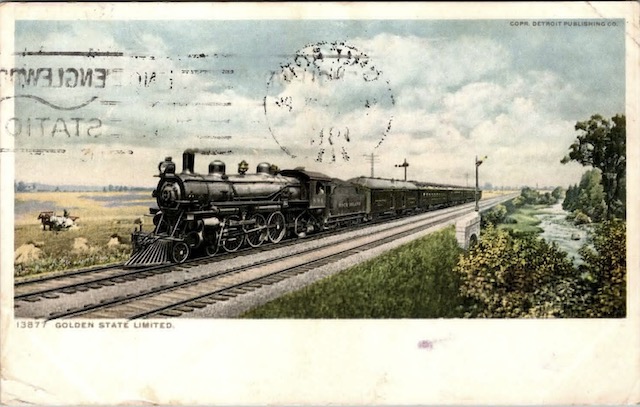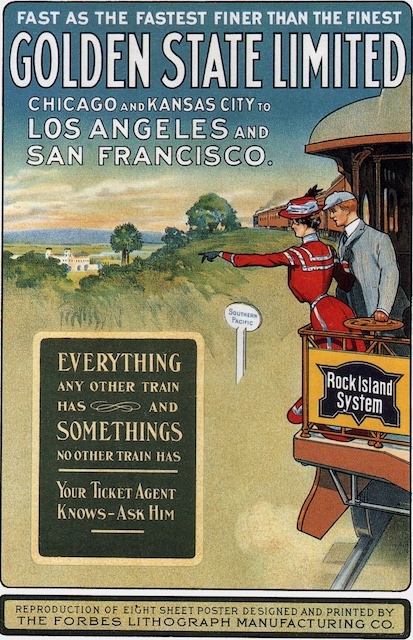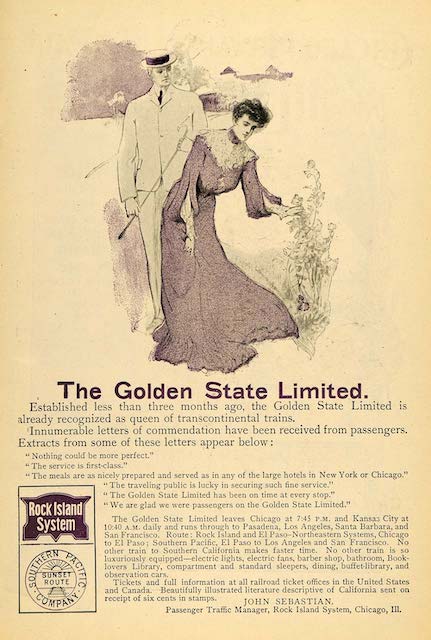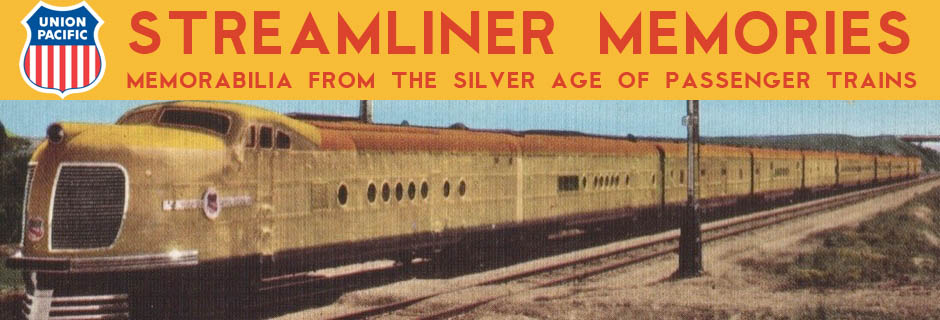In late 1901, Rock Island completed a 264-mile extension from Liberal, Kansas to Santa Rosa, New Mexico. Its goal was to reach coal mines that were opening up in the territory, which wouldn’t become a state until 1912. To that end, New Mexico entrepreneur Charles Eddy built a railroad called the El Paso & Northeastern from Santa Rosa to El Paso, completing it in January 1902. This was one of several railroads that were part of Eddy’s New Mexico Railway and Coal Company.

This card is postmarked 1911 but the photo was probably taken several years earlier. It shows Rock Island locomotive 894 pulling a five-car train. The 1903 locomotive is one of the first 4-6-2 locomotives purchased by the Rock Island. It was never retrofitted with superheaters and produced 28,250 pounds of tractive effort, which is low for a Pacific-type locomotive. Click image to download a PDF of this postcard.
Since El Paso was on the Southern Pacific, the new lines provided a direct connection between Chicago and Los Angeles. At 2,278 miles, this route was 11 miles longer than the Santa Fe’s but had lower grades. At the time, Santa Fe’s California Limited took about 68-3/4 hours from Chicago to Los Angeles and 66 hours back.
Initially, Rock Island and Southern Pacific offered a train that took about 76-1/2 hours. Rock Island advertised that this was “quicker by several hours to Los Angeles than any other train carrying all classes of equipment” — in other words, any train but the California Limited, which didn’t carry coaches or tourist sleepers.
In September, the Los Angeles Herald reported that the Rock Island Railroad held a contest to name a train that would make “the run from [Chicago] to [Los Angeles] as fast as is made by any train,” offering $100 to the winner. More than 7,000 names were entered; the winning entry of “Golden State Limited” was submitted by T.H. Davies, a New York Central agent in Denver. California was officially nicknamed the “Golden State” in 1968, but the term had been in use as early as 1853.
 The Rock Island apparently advertised the Golden State Limited with the long-winded slogan, “Everything any other train has and somethings no other train has.” Click image for a larger view.
The Rock Island apparently advertised the Golden State Limited with the long-winded slogan, “Everything any other train has and somethings no other train has.” Click image for a larger view.
Rock Island/Southern Pacific planned to inaugurate the train on November 2 and proposed running it between Chicago and Los Angeles in just 60 hours. The Santa Fe admitted it could not do better than 66 hours, and the San Francisco Call speculated that this could lead to a “time fight.”
Through the medium of the Transcontinental Passenger Association, whose members were western railroads, the competitors agreed to offer 66-hour services. The passenger association had been formed in 1900 to help prevent the “ruinous competition” that might place if railroads got into rate wars with one another. Today, such associations would violate antitrust laws but they were common in the first half of the 20th century.
 With the Santa Fe and RI/SP coordinating times and fares, the railroads had to compete based on the quality of their services. Click image for a larger view.
With the Santa Fe and RI/SP coordinating times and fares, the railroads had to compete based on the quality of their services. Click image for a larger view.
According to the timetables, only the eastbound trains took 66 hours. The Santa Fe’s westbound limited still took 68-3/4 hours; the Golden State took five minutes more. Like the California Limited, the Golden State Limited started out as a winter-only train and didn’t begin operating all year until 1910. For the rest of the year, Rock Island/Southern Pacific operated a train called the California Special westbound and Chicago Special eastbound that had the same schedule and train numbers as the Golden State Limited but included tourist sleepers and coaches. Apparently, people who want to take coaches or tourist sleepers in the winter had to use the Fast Mail, a year-round secondary train that took about 14 hours more than the Golden State.
The Golden State Limited began life as a five-car train: a baggage-buffet-smoker with a bath and barber shop; an all-compartment sleeping car; a sleeping car with two drawing rooms and 10 sections; a diner; and a sleeping-observation car (which would have had sections). The compartment sleeper went on to Pasadena; the regular sleeper to San Francisco; and the sleeper-observation car to Santa Barbara.
In 1905, Eddy sold his railroads to the Phelps Dodge mining company, which incorporated them into its El Paso & Southwestern Railway. In 1907, the EP&SW leased the portion of Rock Island’s line between Tucumcari and Santa Rosa so it could better use that line for its mining operations. This moved the Golden State Limited‘s hand-off point about 60 miles east from Santa Rose to Tucumcari. In 1924, Southern Pacific bought the EP&SW, and apparently the lease came with it as Tucumcari continued to be the meeting point for the two railroads.
